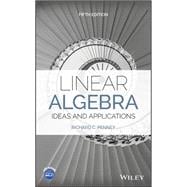Praise for the Third Edition
"This volume is ground-breaking in terms of mathematical texts in that it does not teach from a detached perspective, but instead, looks to show students that competent mathematicians bring an intuitive understanding to the subject rather than just a master of applications."
—Electric Review
Learn foundational and advanced topics in linear algebra with this concise and approachable resource
A comprehensive introduction, Linear Algebra: Ideas and Applications, Fifth Edition provides a discussion of the theory and applications of linear algebra that blends abstract and computational concepts. With a focus on the development of mathematical intuition, the book emphasizes the need to understand both the applications of a particular technique and the mathematical ideas underlying the technique.
The book introduces each new concept in the context of explicit numerical examples, which allows the abstract concepts to grow organically out of the necessity to solve specific problems. The intuitive discussions are consistently followed by rigorous statements of results and proofs. Linear Algebra: Ideas and Applications, Fifth Edition also features:
- A new application section on section on Google’s Page Rank Algorithm.
- A new application section on pricing long term health insurance at a Continuing Care Retirement Community (CCRC).
- Many other illuminating applications of linear algebra with self-study questions for additional study.
- End-of-chapter summaries and sections with true-false questions to aid readers with further comprehension of the presented material
- Numerous computer exercises throughout using MATLAB code
Linear Algebra: Ideas and Applications, Fifth Edition is an excellent undergraduate-level textbook for one or two semester undergraduate courses in mathematics, science, computer science, and engineering. With an emphasis on intuition development, the book is also an ideal self-study reference.








